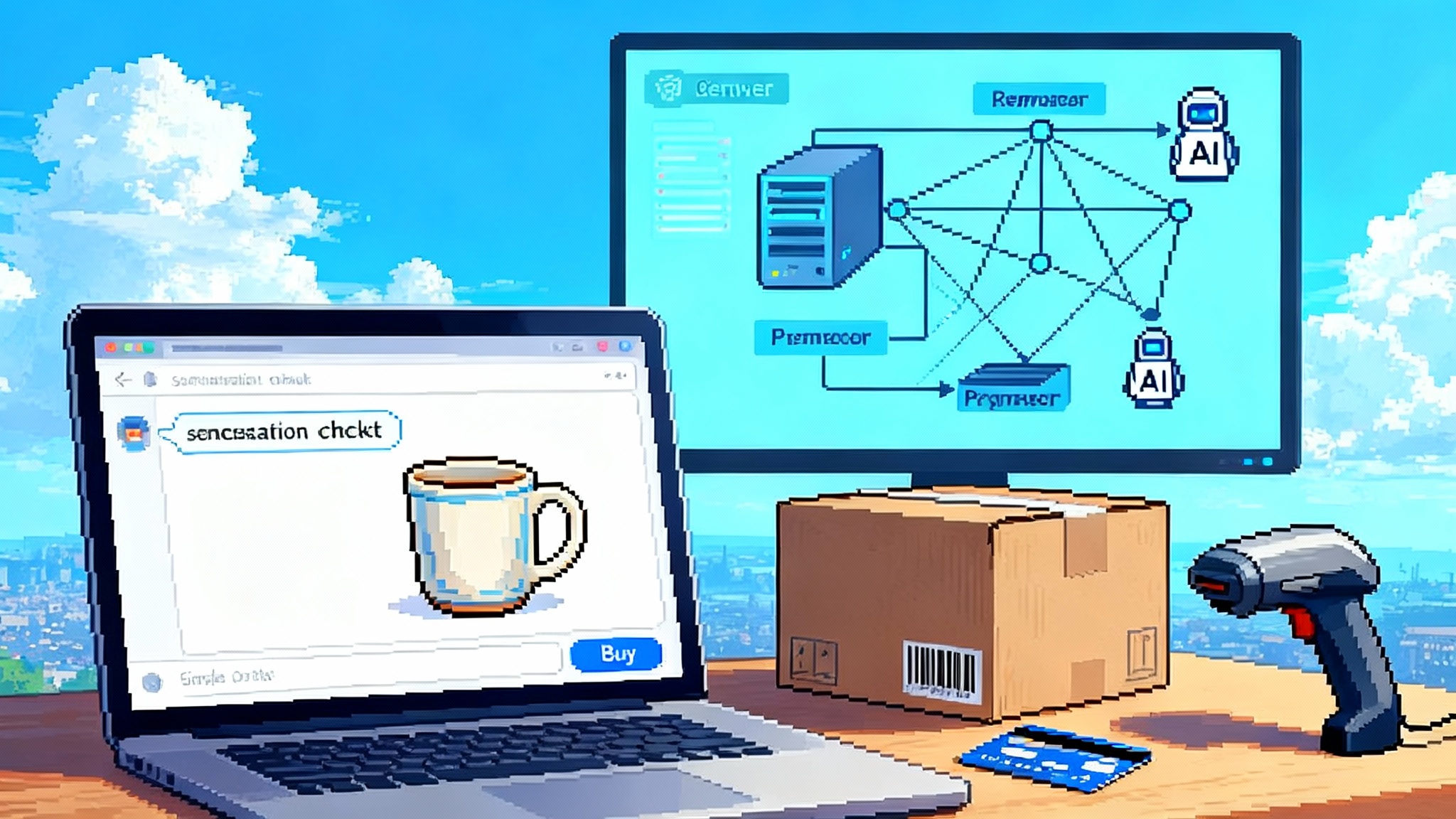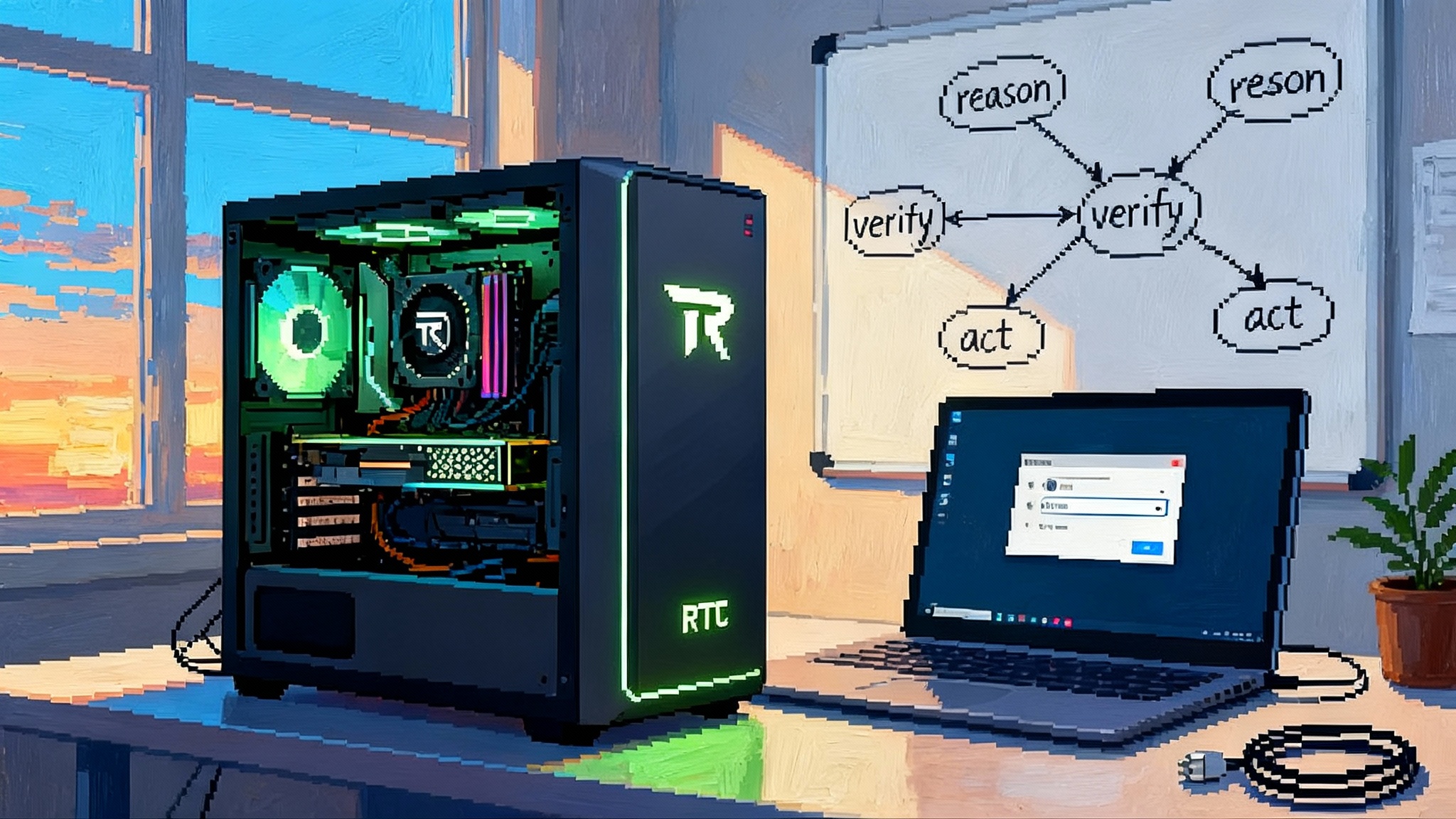Agentic Commerce Arrives: Inside ChatGPT Instant Checkout
Late 2025 pushed AI agents from demos into real checkout flows. See what the Agentic Commerce Protocol standardizes, why retailers and networks are racing to copy or complement it, and a 30-60-90 day plan to get agent ready before the holidays.

The week AI agents started taking payments
On September 29, 2025 OpenAI turned a corner in consumer commerce. ChatGPT moved from suggesting products to actually taking payments through Instant Checkout. The system is powered by a new open standard called the Agentic Commerce Protocol, co‑developed with Stripe and opened to the industry. You can see the details in OpenAI’s own write‑up, which explains what launched and why it matters: OpenAI’s Instant Checkout post.
Two weeks later the signal got louder. On October 14, 2025 Walmart said it would let shoppers complete purchases inside ChatGPT. In the span of fifteen days, agentic shopping went from an intriguing product demo to a checkout channel with real inventory, real payments, and real operational commitments from the largest retailer in the United States.
If you lead commerce at a brand or marketplace, the implications land fast. Your products, policies, and payments now need to be legible to software agents that negotiate, fill carts, and hand off money on behalf of your customers. The companies that make their stores agent ready before the holiday surge will capture incremental demand that will not pass through traditional web pages at all.
What the Agentic Commerce Protocol actually standardizes
The Agentic Commerce Protocol, or ACP, does not try to be a new shopping site. It defines how three parties talk during a purchase: the buyer, their agent, and the business. Think of ACP as the air traffic rules that let many different planes and control towers work together. In practice it standardizes three flows.
1) Catalog and offer feeds
Agents need a dependable source of truth for what you sell, what it costs, and whether it is in stock. The Product Feed specification under ACP gives merchants a schema and a delivery method for that data. It is not just titles and prices. The feed includes availability, inventory counts, variants, media, fulfillment options, and flags that determine whether an item is discoverable and whether it can be purchased in chat.
What changes for you: instead of tuning a search engine optimization feed for human browsers, you now publish a structured catalog built for reasoning systems. Freshness matters. The spec supports frequent updates so agents can avoid recommending out of stock items or stale prices. If you already export feeds for marketplaces, you will recognize the pattern. The difference is that the consumer’s interface is a conversation, not a category page.
Concrete example: a ceramic mug has variants by color and capacity. Your feed groups those SKUs under a parent, includes the right images for each variant, lists inventory, and marks the item as eligible for Instant Checkout. When a shopper tells an agent "I need a 12-ounce mug that ships by Friday," the agent retrieves the right variant and knows it can be bought without leaving chat.
2) Trust, identity, and order state
Agents cannot be a black box. ACP defines how a checkout session is created and updated, which party holds which obligations, and how merchants preserve the customer relationship. The agent presents the buyer’s intent and structured order details. The merchant still validates shipping, taxes, and risk, and the merchant decides to accept or decline the order. The agent mirrors status back to the user in real time.
Trust signals travel with those calls. Merchants receive fields they can run through their existing fraud and risk models. Agents must ask the user to confirm key steps, so consent is explicit. The system surfaces who the merchant of record is, where the order will be fulfilled, and how returns will be handled. In other words, the agent is a courier for state and consent, not a new store that replaces yours.
Concrete example: a parent tells ChatGPT "buy size 6 diapers from the brand we used last time." The agent opens a checkout session with your backend, attaches the prior shipping address from the buyer, includes the maximum authorized amount, and waits. Your stack checks stock, calculates tax, runs risk, and either accepts or declines. The agent then shows a confirmation inside the chat with your order number and support instructions.
3) Payment handoff and settlement
ACP’s delegated payment flow lets the agent carry a one time, tightly scoped payment authorization from the user to the merchant’s existing payment service provider. The merchant remains the merchant of record. Refunds, chargebacks, compliance, and settlement stay in your current stack. That is the key to adoption. You do not have to rip and replace your gateway to support agentic checkout. The protocol is designed to hand you a payment token that your provider recognizes, with built in limits on amount and expiry.
Concrete example: a shopper has a card saved with ChatGPT for their subscription. During checkout, the agent requests a single use payment credential scoped to your merchant account and a maximum of 48 dollars. Your provider processes it like any other charge, and your systems see the same events they always see.
Why retailers and payment networks are racing
Distribution always follows intent. Agents compress the distance between "I need a gift for a ceramics lover" and "order confirmed." That shift is strategic. It moves first contact away from search pages and app grids and into conversations, where the agent curates and completes the journey.
Retailers want two things in this transition. First, they want to be discoverable by agents that control consumer attention. Second, they want to keep control of identity, rules, and money movement once an order starts. ACP offers a route that satisfies both. It helps agents find and describe your catalog while letting you remain the merchant of record. That is why Walmart leaned in so quickly. It is also why marketplaces like Etsy were first to go live, and why Shopify merchants are next.
Payment networks see another angle. They need a reliable way to recognize when an agent, not a browser, is initiating a transaction, and they need to keep fraud tools and identity checks working in that new flow. Visa announced its own schema for identifying trusted agents and passing signed signals at the edge. The company framed it as a compliment to merchant facing standards like ACP, not a replacement. Read their framing in this release: Visa’s Trusted Agent Protocol.
Meanwhile, processors are productizing the handoff. Stripe’s shared payment tokens, and similar approaches by other providers, make it practical for a seller to accept agent carried credentials with usage limits and expiry windows. Card networks are piloting agent identifiers and token upgrades, so that the ecosystem can tell an authorized agent from a rogue bot and so that issuers can explain agent initiated charges to cardholders. The direction of travel is consistent. Make agents verifiable, make payments constrained and revocable, keep the merchant in charge of their customer, and keep the rails interoperable. For a broader view on interoperability, see our take on the interop layer for real agents.
What changes for the shopper
From the shopper’s perspective, the checkout page dissolves. They search, compare, configure, and confirm in one conversational surface. They do not have to retype a card. They do not have to tab through a dozen fields. They get an order confirmation in the chat, and an email from the merchant as usual. Returns still go through the seller. In early rollouts, only single item purchases are supported, but multi item carts are on the roadmap. Related, see how Google is turning the web into an action surface.
This is not the end of websites. It is the beginning of a second interface to your store that is reactive, personal, and multi modal. Voice, images, and video will layer in. Agents will propose baskets for events rather than single items, and they will learn lingering preferences across sessions. The key is that trust and control are explicit. The user authorizes every step.
The 30-60-90 day playbook to go agent ready before the holiday surge
There is still time to be ready for peak season. Ship in phases, using the protocol’s modular design.
Days 0-30: Make your catalog legible to agents
- Stand up a compliant product feed
- Export a structured catalog that includes identifiers, price, inventory, media, variants, shipping methods, and eligibility flags for search and checkout.
- Refresh cadence: plan for updates at least hourly for fast movers, and nightly for long tail items. Automate deltas to cut bandwidth.
- Decide where Instant Checkout can apply
- Start with replenishable goods, standardized items, and giftable products. Avoid complex configurations that need custom fields until you test post purchase personalization flows.
- Add guardrails in product data
- Use short, accurate titles, no policy sensitive claims, and enforce consistent units. Agents reason over text; sloppy fields increase hallucinations. For governance patterns, study governed building blocks for agents.
- Build a simulation run
- Test your feed against a sandbox agent. Verify that the right variants surface, that discontinued SKUs are excluded, and that pricing and taxes round as expected.
Days 31-60: Wire up agentic checkout on your terms
- Implement the checkout endpoints defined by ACP
- Start with create, update, and complete operations. Treat the agent as a first party client that needs the same validations as your web checkout.
- Keep your risk posture
- Run your existing fraud checks. Use the agent’s structured intent and identity signals as features. Set clear decline reasons so the agent explains them cleanly to the user.
- Bring your own payments
- Work with your payment service provider to enable agent carried, single use tokens with caps on amount and expiry. Map these to your order state so customer support can see the full trail.
- Design the post purchase trail
- Ensure order numbers, shipment tracking, and return policies are visible to the agent. The chat should display the same facts your email does, so customers can self serve without confusion.
- Define attribution and measurement
- Decide how you will tag agentic orders in your data warehouse. Use campaign metadata fields to capture creative, prompt, or audience experiments. Establish a baseline conversion from agent browse to agent checkout.
Days 61-90: Scale, govern, and prepare for multi item carts
- Expand eligibility to multi item scenarios
- Model bundles and baskets in your feed. Define shipping and discount rules at the order level. Validate tax logic for mixed carts.
- Add brand guardrails and policy checks
- Create allow lists for categories where agents can actually buy, with price caps and per day limits. Enforce age gates and restricted goods rules server side, not just in content.
- Instrument the new funnel end to end
- Build dashboards for agent referred impressions, add to cart attempts, declines by reason, and successful completes. Track customer service contacts that originate from agentic orders to spot friction.
- Stand up a rollback plan
- If you see abnormal declines, timeouts, or abuse, be ready to flip items back to link out only. Your feed’s eligibility flags are your circuit breakers.
- Train your teams
- Give your support reps a one page explainer on how agentic orders look in your tools. Teach merchandising how to tune feed attributes that influence agent recommendations. Add a playbook for disputes that involve agents.
Do's and don'ts from early pilots
- Do start with one category and one region. The fastest wins show up where preferences are predictable and logistics are stable.
- Do keep your existing checkout polished. Many agent sessions will still hand off to your site until multi item carts and customizations are fully supported.
- Do tune content for clarity. Agents summarize descriptions, compare features, and answer objections. Ambiguous or promotional copy hurts relevance. Specific bullets win.
- Do audit legal and safety constraints. Prohibit purchase in prohibited categories in your feed. Design a hard decline for risky destinations or age restricted goods, and let the agent explain why.
- Do not hide behind black box decisions. If you decline, return a reason code that is legible. The agent will translate it into customer friendly language and reduce support tickets.
- Do not over rotate on paid placement yet. Instant Checkout results are not sponsored. Win on relevance, availability, and quality signals.
What success will look like by January
Expect three changes in your analytics if you execute this plan.
- A new, small but growing order source called agentic checkout. It will start in single digits as a share of online orders in November and December, but it will compound. Your best products and replenishment items will see it first.
- A drop in checkout abandonment for eligible products. The distance from intent to payment shrinks, so fewer shoppers fall out between add to cart and submit.
- A clearer feedback loop on product quality. Agents expose missing data quickly. You will find and fix inconsistent sizes, unclear images, and return prone items faster because the conversational interface forces precision.
The competitive map is changing
There is a reason card networks, acquirers, and content delivery networks are shipping their own agent protocols and token frameworks. Everyone wants to make the new supply chain of intent, identity, and money interoperable. Visa’s move to label and verify trusted agents at the edge complements ACP’s merchant side flows. Merchant platforms will offer one click switches to publish ACP feeds, accept delegated payment tokens, and mark certain items as agent buyable. Processors will expose reports that explain which transactions were agent initiated and whether the cardholder had pre authorized the agent.
This is not about replacing the web. It is about building a parallel lane where software handles the clicks and humans handle the choices. The first companies to master both lanes will grow faster than the ones that keep trying to push everyone through a twelve field form.
The bottom line
Agentic commerce is now in production. The playbook is straightforward. Publish a high quality product feed that agents can trust. Implement the order and payment handoff that lets you stay the merchant of record. Set guardrails so the agent only buys what you want it to buy. Instrument the funnel so you can learn and scale. For product teams building the plumbing, start with OpenAI’s Instant Checkout post and Visa’s view on trusted agents above.
If you move in the next ninety days you will not just be ready for the holidays. You will be ahead of the curve in 2026, when multi item carts, voice first shopping, and cross agent baskets start to feel normal. Software is ready to shop on your customer’s behalf. Make sure your store is ready to sell.








